#pleurotus species
Text
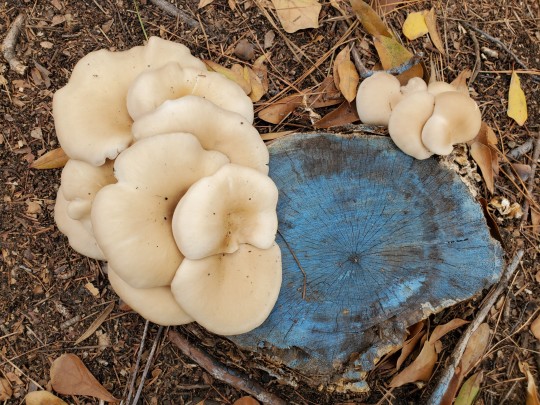


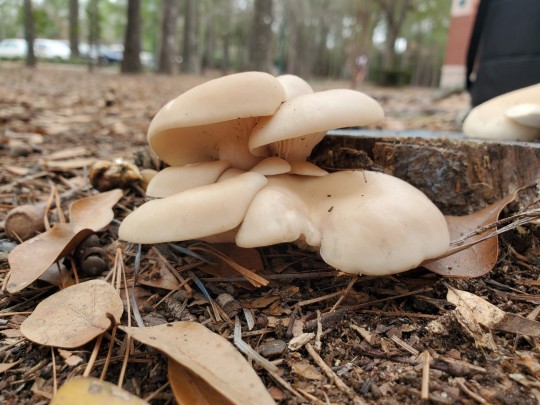
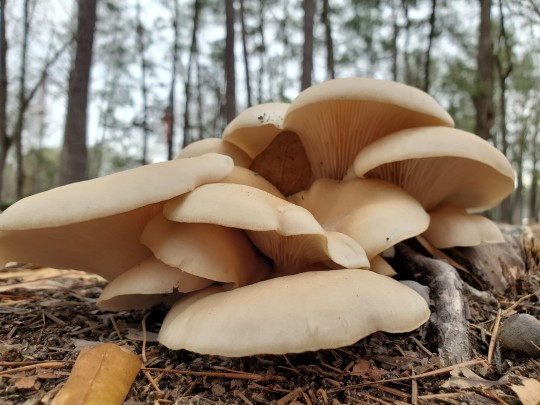
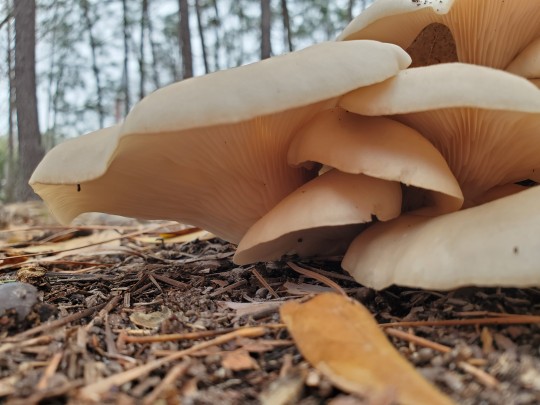

Oyster mushrooms!! 》 Pleurotus ostreatus
Gorgeous flush of oysters on campus!!!
I had seen some strange but similar fellows here last semester and IDed them as funnel woodcaps or perhaps linx paw oysters due to their fuzzy stems, but these dont appear to be quite the same species.
The president of the school stopped and chatted with me about them. She asked twice if my observation was related to my major. Nope, just my special interest. 😅
Southeast Texas, 8 Feb. 2023
#amatuer mycology#mushroom hunting#mushrooms#mycology#fungi#mushrooms of texas#texas mushrooms#wild fungi#fungi of texas#fungarium#foraging#local fungi#mushroom species#special interest#species identification#oysters#oyster mushrooms#pleurotus ostreatus#pleurotus species#wild oyster mushrooms#wild mushrooms#edible mushrooms#mushroom
13 notes
·
View notes
Text

Title
MYCELIUM
The cultivated and photographed species were Pleurotus Citrinopileatus, Hericium Erinaceus and Pleurotus Djamor.
Luiz Fernando Lopes Calvi
Brazil
Neutral Density Photography Awards 2023




#luiz fernando lopes calvi#photographer#brazil#mycelium#mushrooms#pleurotos citrinopileatus#hericium erinaceus#pleurotus djamor#fungi#fungus#nature#neutral density photography awards
163 notes
·
View notes
Note
do you know much about mushroom cultivation? if so, would it be feasible to have an isopod colony living inside a mushroom grow tank like a monotub? both are generally kept humid and warm, and the isopods could eat the mushrooms and when the isopods die the mushrooms could eat the isopods. and there'd be cool mushrooms and cool bugs like next to each other. it would be beautiful.
I have very limited knowledge of fungus cultivation, but I do know that the “mushrooms eat isopods” bit would not work here. isopods like eating each other much more than mushrooms do, and will do that much faster. unless something is horribly wrong, isopods do not leave any evidence of their dead.
I also do not think mushrooms are a complete diet for isopods, who need a plant-based diet of leaves (and less so wood). you would need to provide them with leaf litter + veg/protein treats even if the isopods did want to eat the mushrooms or the mushroom growth media (which might well be more edible to them than the fungus).
I still think the idea would be feasible if you used mushrooms as more of a decoration, and picked something very hardy like Pleurotus that can eat whatever junk you grow it on. build a normal isopod tub, but bury a plug of inoculated mushroom spawn in the substrate somewhere, and if you keep the soil moist you’ll probably get some mushroom/isopod cohabitation going on.
also, don’t keep isopods warm unless they’re tropical species. most of the common varieties are native to cold areas of Europe and weather freezing temperatures most of the year. I find all of my species breed best at about 70F° or slightly under that.
59 notes
·
View notes
Note
what's the most recent mushroom fact you learnt??
THANK YOU FOR ASKING THIS !!
carnivorous fungi : fungi that derive some or most of their nutrients from consuming microscopic or minute animals.
most of these species trap & stun nematode worms (pictured below), making them nematophagous organisms.

other carnivorous fungi may attack amoebae or collembola (pictured below).
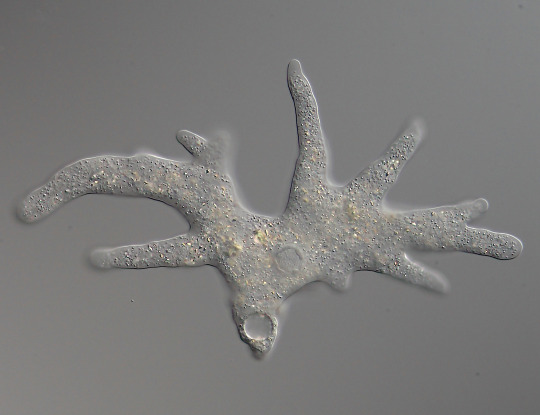

fungi trap & eat these tiny animals in two main ways :
constricting rings (also called active traps)
adhesive structures (also called passive traps)
some fungi have a profound ability to "sense" when a nematode worm is near before activating their "traps". scientists are unsure how they evolved this ability without proper brains.
in total, there are about 150 species of fungi that attack, kill & digest animals.
a good example is pleurotus ostreatus (pictured below), which uses a calcium-dependent toxin to paralyse its prey (nematode worms) within minutes, & leads to necrosis of the miniscule animal. it acts as quite a protein-rich food source !!
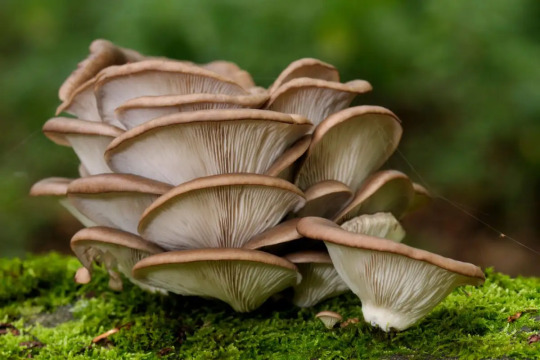
another fun fact : i used to farm these at home :-)
#• finn's freaky fungi fact ^^ •#• askbox replies: •#(ask : anonymous user)#||#THANK YOU ANON#THANK YOU SO MUCH#PLEASE ASK THIS ALL THE TIME I AM CONSTANTLY LEARNING#<33#|#fungi#fungus#mushrooms#mycology#mushroom#nature#earth#science#biology#carnivore#carnivorous fungi#fun fact
111 notes
·
View notes
Text
“The life cycle of most basidiomycetes encompasses two distinct phases: those of the monokaryon and the dikaryon. Initially, a meiotic haploid spore germinates, giving rise to a mycelium with uninucleate cells, the monokaryon. This mycelium can grow vegetatively and, when it meets another monokaryon of the same species, hyphal fusions occur between the two mycelia (figure 1). At that moment fertilization of the mycelium can occur. In most mushroom-forming basidiomycetes, fusion is followed by exchange of nuclei but not cytoplasm [7,8], resulting in a mycelium with binucleate cells, the dikaryon. Nuclei migrate from the contact zone through the whole receiving mycelium [9]. The exact process of dikaryotization is unknown, but it must involve many nucleus duplications because the outcome of dikaryotization is that all cells of both receiving mycelia contain both nucleus types (figure 1b). Just like the monokaryon, the dikaryon can grow vegetatively, but it is also able to form sexual fruiting bodies (the mushrooms). In the fruiting bodies, the two nuclei fuse, directly after which meiotic spores are produced. A dikaryon can no longer accept other nuclei, but it can still donate nuclei to a monokaryon [10,11], a phenomenon called the ‘Buller phenomenon”
“The primary mycelium (monokaryon) of basidiomycete fungi, growing from a germinating sexual spore, is hermaphroditic, but it loses female function upon the acceptance of a second nucleus. The resulting dikaryon with two different nuclei in each cell retains a male potential as both nuclei can fertilize receptive mycelia. “
“Sexual selection is expected to occur during a dikaryon–monokaryon (di–mon) mating because both nuclei (analogous to male gametes) of the dikaryon are able to fertilize the receiving monokaryon (analogous to the female gamete)”
“The monokaryotic and dikaryotic conditions can be distinguished by the presence of clamp connections in dikaryons and their lack in monokaryons. Clamp connections are hook-shaped structures involved in equal nuclei sorting to the daughter cells produced by mitosis.”
2 notes
·
View notes
Note
If characters on AMC IWTV were mushrooms, what would they be?
Omg.
So my immediate thought was that Lestat is a chanterelle, because he's ginger and because I always assumed that was a French name. Doesn't it sound like it's related to "chanteuse" or something?? But I just googled it and apparently it's Greek in origin, which is dumb. Whatever, Lestat is a chanterelle.
Louis is Pleurotus ostreatus, the oyster mushroom. Stunning, beautiful gills and a choice edible, but man, so clingy. RIP to the tree it decides is the love of its life
Claudia is a baby Amanita virosa, a fool will be like "Oh wow is this a delicious Agaricus mushroom? Let me have a taste" and die of multiple organ failure because obviously it was a Destroying Angel species
#follow for more hot takes#nature#the fungus among us#interview with the vampire#ETA 'chanterelle' is still French just derived from a Greek word
13 notes
·
View notes
Text
The oyster mushroom (Pleurotus ostreatus) is a staple of many kinds of cuisine, prized for its mild flavors and a scent vaguely hinting at anise. These cream-colored mushrooms are also one of several types of carnivorous fungi that prey on nematodes (roundworms) in particular. The mushrooms have evolved a novel mechanism for paralyzing and killing its nematode prey: a toxin contained within lollipop-like structures called toxocysts that, when emitted, cause widespread cell death in roundworms within minutes. Scientists have now identified the specific volatile organic compound responsible for this effect, according to a new paper published in the journal Science Advances.
Carnivorous fungi like the oyster mushroom feed on nematodes because these little creatures are plentiful in soil and provide a handy protein source. Different species have evolved various mechanisms for hunting and consuming their prey. For instance, oomycetes are fungus-like organisms that send out "hunter cells" to search for nematodes. Once they find them, they form cysts near the mouth or anus of the roundworms and then inject themselves into the worms to attack the internal organs. Another group of oomycetes uses cells that behave like prey-seeking harpoons, injecting the fungal spores into the worm to seal its fate.
Other fungi produce spores with irritating shapes like stickles or stilettos. The nematodes swallow the spores, which get caught in the esophagus and germinate by puncturing the worm's gut. There are sticky branch-like structures that act like superglue; death collars that detach when nematodes swim through them, injecting themselves into the worms; and a dozen or so fungal species employ snares that constrict in under a second, squeezing the nematodes to death.
The oyster mushroom eschews these physical traps in favor of a chemical mechanism. P. ostreatus is what's known as a "wood rotter" that targets dead trees, but wood is relatively poor in protein. Its long branching filaments (called hyphae) are the part of the 'shroom that grows into the rotting wood. Those hyphae are home to the toxocysts. When nematodes encounter the toxocysts, the cysts burst, and the nematodes typically become paralyzed and die within minutes. Once the prey is dead, the hyphae grow into the nematode bodies, dissolving the contents and absorbing the slurry for the nutrients.
Read the rest
3 notes
·
View notes
Note
top 5 mushrooms!!!!!
1. Pink oyster (Pleurotus djamor)
2. It’s purple! (Entoloma occidentale) it was recently found in Arizona!
3. Fly agaric (Amanita muscaria)
4. Dryad Saddle (Cerioporus squamosus), note it is not trypophobia friendly. This is my research species so…
5. Giant Puffball (Calvatia gigantea)
2 notes
·
View notes
Text
Why Mushroom Supplement Powder is Popular Among Health Enthusiasts?

In recent years, health enthusiasts have been gravitating towards natural supplements, and one standout in this category is mushroom supplement powder. This trend is more than just a passing phase; it is rooted in the substantial health benefits that these fungi offer. Here’s a detailed look at why mushroom supplement powder has become a staple for those committed to maintaining and enhancing their well-being.
A Historical Perspective
Mushrooms have been used for centuries in various cultures for their medicinal properties. Traditional Chinese Medicine, Ayurveda, and even ancient Egyptian practices have documented the use of mushrooms for their healing benefits. Modern science has started to validate many of these traditional uses, shedding light on the potent bioactive compounds found in mushrooms.
Rich Nutrient Profile
Mushroom supplement powders offer a natural, holistic approach to enhancing health, making them a valuable addition to any wellness routine. It is derived from various species, each boasting a unique nutrient profile. Brainezy used mushrooms include:
Lion’s Mane (Hericium erinaceus) stands out for its cognitive benefits. Rich in antioxidants and anti-inflammatory properties, it supports memory and focus, potentially aiding nerve regeneration and bolstering the immune system. It may also help manage anxiety and depression.
Turkey Tail (Trametes versicolor) is renowned for its immune-boosting polysaccharides, enhancing the body’s defense mechanisms. Research suggests it supports cancer treatment, improves gut health, and reduces inflammation.
Shiitake (Lentinula edodes), a staple in traditional medicine, is rich in lentinan, which bolsters the immune system and combats infections. These mushrooms also contain vitamins, minerals, and antioxidants that may lower cholesterol, support heart health, and exhibit anti-cancer properties.
Reishi (Ganoderma lucidum), known as the “mushroom of immortality,” has been used in traditional Chinese medicine for centuries. It boosts the immune system, reduces inflammation, and supports overall well-being. Its adaptogenic properties help manage stress, improve sleep, and enhance longevity.
Cordyceps enhances endurance and energy levels by improving oxygen utilization, making it popular among athletes. It supports respiratory health, reduces inflammation, and strengthens the immune system, contributing to overall vitality.
Chaga (Inonotus obliquus), a powerhouse of antioxidants, supports immune function, reduces oxidative stress, and improves skin health. It’s being researched for potential anti-cancer and anti-aging benefits.
Maitake (Grifola frondosa), also known as “Hen of the Woods,” supports immune function with its beta-glucans. It may help regulate blood sugar levels and improve insulin sensitivity, offering potential benefits for those with diabetes or metabolic issues.
Tremella (Tremella fuciformis Berk), the “beauty mushroom,” is rich in natural hyaluronic acid, which maintains skin moisture and elasticity, promoting a healthy complexion.
King Trumpet (Pleurotus eryngii), offers culinary delight and health advantages. It’s a great source of ergothioneine, an antioxidant that protects cells from oxidative stress, and is rich in vitamins, minerals, and protein, supporting immune health and overall well-being.
Immune System Support
One of the primary reasons health enthusiasts are turning to mushroom powder is its ability to boost the immune system. The beta-glucans found in mushrooms activate various immune cells, enhancing the body’s ability to fight off infections and diseases. Regular consumption of mushroom powder can lead to a more resilient immune response, which is particularly beneficial during cold and flu season.
Cognitive Enhancement
In an age where cognitive performance is highly valued, mushrooms like Lion’s Mane have gained popularity for their neuroprotective properties. Studies suggest that compounds in Lion’s Mane promote the production of nerve growth factor (NGF), which supports the maintenance and regeneration of neurons. This can lead to improved memory, focus, and overall brain health, making it a favorite among students, professionals, and older adults.
Stress Reduction and Adaptogenic Properties
Reishi and Cordyceps are renowned for their adaptogenic properties, which help the body adapt to stress and restore balance. These mushrooms can modulate the body’s stress response, reduce anxiety, and promote a sense of calm. In today’s fast-paced world, the ability to manage stress effectively is crucial, and mushroom supplements offer a natural solution.
Antioxidant Powerhouse
Mushrooms like Chaga are incredibly rich in antioxidants, which play a critical role in protecting the body from oxidative stress and free radical damage. Antioxidants help to reduce inflammation, slow down the aging process, and lower the risk of chronic diseases. Incorporating mushroom powder into a daily routine can thus contribute to long-term health and vitality.
Enhanced Energy and Endurance
For those leading active lifestyles, Cordyceps has become a go-to supplement. Known for increasing ATP production (the energy currency of the cell), Cordyceps can boost physical performance, enhance stamina, and speed up recovery. Athletes and fitness enthusiasts often add Cordyceps powder to their pre-workout routines to gain a natural edge.
Versatile and Easy to Incorporate
One of the practical reasons for the popularity of mushroom supplement powder is its versatility. It can be easily added to smoothies, coffee, tea, soups, and even baked goods. This ease of incorporation makes it simple for individuals to enhance their diet without making significant changes to their daily routines.
Conclusion
The popularity of mushroom supplement powder among health enthusiasts is well-founded, given its myriad of health benefits. From boosting the immune system and enhancing cognitive function to providing stress relief and improving physical performance, mushrooms offer a natural, holistic approach to health. As research continues to unveil more about these incredible fungi, it’s likely that their popularity will only continue to grow. For those looking to enhance their well-being naturally, mushroom supplement powder is a powerful and versatile addition to their health regimen.
#organic mushroom supplements#mushroom supplements nz#mushroom powder#mushroom supplements#organic mushroom extract#organic mushroom blend#mushroom powder nz#functional mushroom nz#best mushroom supplements auckland#9 in 1 mushroom blend#functional mushrooms coffee#mushroom benefits of mushroom#organic mushroom#organic mushroom extract new zealand#medicinal mushrooms#mushroom near me#organic store auckland#Functional mushrooms coffee#Functional mushroom NZ#Best Mushroom Powder
0 notes
Text
Cooleenup Island Species List - FUNGI AND LICHENS
June 9th to 11th, 2023
12C-18.5C, 2.4mm-12.5mm rain, strong wind on Sunday
FUNGI & SLIME MOLDS (17 spp.)
Scotsman’s Beard Calocera guepinioides
Slimy Yellow Cortinar Cortinarius sinapicolor
Oysterling Crepidotus sp.
Woody Layered Bracket Fungus Fomitiporia robusta
Wasp Nest Polypore Hexagonia vesparia
Bolete Eater Fungus Hypomyces chrysospermus
Mycena tenerrima
Mycena sp.
Ghost Mushroom Omphalotus nidiformis
Lavender-pored Bracket Fungus Phaeotrametes decipiens
Violet Skin Fungus Phlebiopsis crassa
Southern Oyster Mushroom Pleurotus australis
Cleland’s Gilled Bolete Phylloporus clelandii
Earthball Scleroderma sp.
Southern Cinnabar Polypore Trametes coccinea
Yellow Brain Fungus Tremella mesenterica group
White Treetrunk Slime Mold
LICHENS
At least 6 species, including two growing on the veranda of the field station.
Only confirmed species Cladia muelleri, growing on sand at the eastern end of the island.
1 note
·
View note
Text
Unveiling the Magic: Blue Pearl Oyster Mushroom Liquid Culture Syringes Introduction:
Unlocking the Potential:
Blue Pearl Oyster Mushrooms, scientifically known as Pleurotus ostreatus var. columbinus, boast a stunning blue hue that sets them apart from their more common oyster mushroom counterparts. Cultivating these mushrooms from liquid culture syringes offers cultivators a streamlined and reliable approach to propagate this captivating species.
Advantages of Liquid Culture Syringes:
Consistency and Sterility: Liquid culture syringes provide a highly controlled and sterile environment for mushroom cultivation. This minimizes the risk of contamination, ensuring a consistent and successful growth of Blue Pearl Oyster Mushroom Liquid Culture Syringes.
Ease of Use: These syringes simplify the inoculation process, making it accessible for both novice and experienced cultivators. The liquid culture can be easily dispensed onto the chosen substrate, facilitating a smooth and efficient start to the cultivation journey.
Faster Colonization: Liquid culture promotes faster mycelium colonization compared to traditional methods. This acceleration allows cultivators to witness the mesmerizing development of the Blue Pearl Oyster Mushrooms at an expedited pace.
Multiple Inoculations: A single liquid culture syringe often contains enough mycelium for multiple inoculations, enabling cultivators to expand their mushroom cultivation efforts and experiment with different substrates.
Cultivation Process:
Preparation: Before inoculation, prepare a suitable substrate, commonly a mix of grains and other nutrient-rich materials. Sterilize the substrate to eliminate any competing organisms.
Inoculation: Using a Buy Premium Mushroom Liquid Culture Syringes, inject the mycelium into the sterilized substrate. Ensure a clean and controlled environment to prevent contamination.
Incubation: Place the inoculated substrate in a controlled environment with proper temperature and humidity. Allow the mycelium to colonize the substrate fully, forming a dense network.
Fruiting: Once colonization is complete, introduce the substrate to a fruiting environment. The unique blue caps of the Blue Pearl Oyster Mushrooms will begin to emerge, creating a visually stunning and rewarding harvest.
0 notes
Text
Comparing Spore Varieties: Choosing the Right Premium Spores for Your Mushroom
Embarking on a mushroom cultivation project is an exciting venture, and selecting the right spores is a crucial first step. The world of premium spores offers a diverse range of options, each with its unique characteristics and benefits. In this guide, we'll navigate through the intricacies of spore varieties to help you make an informed decision for your mushroom project.
Understanding Premium Spores
Premium spores serve as the foundation for your mushroom cultivation, influencing the species, growth characteristics, and, ultimately, the success of your project. Let's delve into the key considerations when comparing spore varieties.
1. Mushroom Species Selection
Different spores correspond to different mushroom species. Whether you're interested in the classic White Button mushrooms or the exotic Shiitake variety, understanding the species associated with each premium spore is fundamental.
2. Growth Medium Compatibility
Premium spores come with specific growth requirements. Some varieties thrive in specific substrates, such as grain, while others prefer a mix of wood chips and straw. Matching the spore variety with a compatible growth medium is essential for successful cultivation.
3. Environmental Conditions
Each mushroom species has its preferred environmental conditions, including temperature, humidity, and light exposure. Assess the climate and growing space available for your project to ensure it aligns with the requirements of your chosen premium spores.
4. Yield and Growth Characteristics
Consider the yield and growth characteristics of the mushrooms produced by different spore varieties. Some may be prolific fruiters, while others might take a bit longer to mature. Understanding these traits helps you manage expectations and plan your cultivation timeline.
Choosing the Right Premium Spores
Now that you have a grasp of the considerations let's explore the diverse world of premium spores.
1. Classic White Button Spores
The White Button mushroom (Agaricus bisporus) is a popular choice for its mild flavor and versatile culinary uses. It's an excellent option for beginners due to its ease of cultivation.
Characteristics: Fast-growing with a relatively short cultivation time, White Button mushrooms are well-suited for those new to mushroom cultivation.
2. Exotic Shiitake Spores
Shiitake mushrooms (Lentinula edodes) are renowned for their rich, savory flavor and extensive use in Asian cuisine. They have both culinary and potential medicinal applications.
Characteristics: Shiitake mushrooms have a distinctive cap shape and grow well on a substrate of hardwood sawdust or a mix of hardwood chips and straw.
3. Enigmatic Morel Spores
Morel mushrooms (Morchella) are highly prized for their unique, honeycomb appearance and earthy flavor. They're considered a gourmet delicacy.
Characteristics: Morels have specific growth requirements, often thriving in nutrient-rich soils and symbiotic relationships with certain trees.
4. Vibrant Oyster Spores
Oyster mushrooms (Pleurotus) come in various colors, including white, pink, and yellow. They have a delicate taste and a velvety texture.
Characteristics: Oyster mushrooms are known for their versatility and can be cultivated on a variety of substrates, including straw and coffee grounds.
Conclusion
Choosing the right premium spores is an exciting yet crucial aspect of your mushroom cultivation project. Whether you opt for the classic White Button, exotic Shiitake, enigmatic Morel, or vibrant Oyster, each spore variety brings its unique charm to the growing table.
1 note
·
View note
Text
OYSTER MUSHROOMS

Oyster mushrooms are beloved the world over for their delicate texture and mild, savoury flavour. The cap of the mushroom is convex and shell shaped, when opening out they flatter with waves and sometimes have split edges. they are usually smoky grey, silver and brown. The gills are crowded and white however as it goes down the stem it turns slightly yellow. The stem is white and opens out to the cap. finally the flesh of the mushroom is white and tough in the stem.
The Oyster Mushroom has some amazing properties one of which is that it is a carnivorous mushroom which traps and ingests nematode worms to provide it with nitrogen and other useful chemicals. The species of genus Pleurotus contain statins which are thought to help reduce cholesterol.
Another is the fact that they have the ability to clean up pollution by hydrocarbons like petrol and oil which is quite incredible.
This specific type of fungus stood out to me as I really liked the look of the gills. I wanted to choose fungus which allowed me to generate the most ideas and oyster mushrooms allowed me to do this. the ideas that I have so far are pleats and experimenting with multiple textured fabric techniques. as for my illustration I am going to experiment with different shapes and silhouettes. I plan to create a double pages spread for this type of fungi in order to extend my research further.
HARVARD REFERENCE
Wild Food UK. (2023). Oyster Mushroom. [Online]. Wild Food UK. Last Updated: January 2023. Available at: https://www.wildfooduk.com/mushroom-guide/oyster-mushroom/ [Accessed 15 April 2023].
0 notes
Text
Report frassini (Fraxinus excelsior)
Lombardia, 12/03/2023, 200[m]
I frassini stanno lentamente risvegliandosi. Alcuni hanno le caratteristiche gemme nere del frassino maggiore ancora chiuse, altri esemplari le hanno ormai rigonfie e pronte a fiorire, altri ancora hanno ormai i primi fiori nello stadio iniziale del loro sviluppo...



Le infiorescenze del frassino non sono particolarmente vistose né adatte a uno scopo decorativo/ornamentale, ma è molto importante per un fungaiolo saperle riconoscere!
Ho osservato che alcune gemme sono un po' secche perché stanno patendo la mancanza d'acqua e di umidità. Il terreno è abbastanza secco, specie nelle zone esposte, e i piccoli corsi d'acqua sono asciutti: la siccità si fa sentire. Ma pare che quest'ultima ci abbandonerà nella notte a cavallo tra martedì sera e mercoledì mattina. Se le precipitazioni fossero confermate allora la stagione delle Morchelle potrebbe iniziare sotto un buon auspicio. Ricordiamoci che si parte dalla pianura, dove le grandi precipitazioni concentrate in poco tempo hanno un effetto molto più benefico rispetto alla montagna, dato che l'acqua si accumula sul terreno e non scivola via (una parte defluisce subito verso i corsi d'acqua o le pozze ma quantomeno l'assorbimento è maggiore).
Non saprei quantificare quanto tempo rimane da attendere prima di trovare le prime Morchelle. I frassini si stanno attivando ma ciò che manca, per ora, è la temperatura adeguata, che non dovrebbe scendere sotto i 7°C e superare almeno i 15°C per un ragionevole lasso di tempo. Manca anche un adeguato tasso di umidità, che dovrebbe ristabilirsi mercoledì se le precipitazioni fossero confermate.
Nonostante le temperature piuttosto miti per la prima metà di marzo, non ho trovato funghi primaverili, ma solo un vecchio Pleurotus ostreatus e dei funghi della famiglia dei Coprinus (tipicamente nella fase deliquescente). Probabilmente questo stallo non è tanto dovuto alle temperature quanto alla penuria d'acqua.
Comunque, la primavera è alle porte e con lei anche la stagione dei funghi! Prepariamoci al nostro meglio: controlliamo in anticipo la nostra attrezzatura - ad esempio mi sono accorto che devo sostituire un laccio degli scarponi che, se si rompesse, renderebbe le mie camminate estremamente scomode se non impossibili. Organizziamo gli impegni in modo da non accavallarsi troppo con il tempo libero da dedicare alla raccolta dei funghi.
Un saluto e a breve altri aggiornamenti...
Sabato 18 marzo




I frassini sono quasi tutti in fiore, la maggioranza... Tra una decina di giorni si dovrebbero aprire le danze, un po' d'acqua non farebbe male...
0 notes
Text




Was determined to find my first Pleurotus this winter, and lo and behold! It was right on the trail, quite conspicuously. Oddly this species wasn't listed in my guide (so probably a rare or uncommon find in my area), but likely P. dryinus/levis. Note the veil remnants on the edge of the cap.
Second find of the day is Auricularia fuscosaccinea. At least, that's what I called it on mushroom observer and no one corrected me. So it has to be correct right? This belongs to a group of species more commonly known as wood ear.
1 note
·
View note